Varamyr’s Abominations:
Did Breaking Skinchanging Taboos Unlock More Power?
What happens when a warg breaks the taboos skinchanging? Varamyr’s story leads to an interesting conclusion. Would you believe his magical prowess actually increased after breaking the very taboos Haggon warned him about? I believe Varamyr’s transgressions were the key to his rise as one of the most powerful skinchangers North of the Wall.
Taboos are basically like a code of ethics defining the limits of acceptable behaviour in the skinchanger community. Though Haggon often talked about these “abominations,” he never really spelled out what the consequences of violating them might be.
This is a two-part analysis. In this post, we’ll explore Haggon’s taboos and their impact on Varamyr’s magical power. The second part will compare Varamyr and Bran, taking a look at whether violating warging taboos has accelerated Bran’s progress towards greenseeing.
Costs and Benefits of Breaking Societal Norms
Breaking societal norms doesn’t always come at a cost to the offender. Historically, taboos function as laws, protecting societal cohesion. Stealing in some cultures was penalized by cutting off the offender’s hand, while modern common law might impose community service or a jail sentence, based on the crime’s severity. But what happens when a thief isn’t caught? They stand to gain significantly. Think in this context also of Davos Seaworth:
He was an accomplished smuggler who once secured his livelihood by breaking taboos associated with piracy and theft. He lost his fingers to Stannis’ justice, a milder form of punishment due to his saving the besieged garrison from starvation. Paradoxically, breaking that taboo ultimately brought him great benefits – he may have lost the fingers of one hand but he gained a lordship, lands to go with it and secured an education and elevated social status for his younger sons.
In this sense, breaking taboos, or committing crimes, can sometimes be highly rewarding, and this scenario probably holds true for Varamyr Sixskins.
To illustrate this point further, let’s consider some significant real-life examples of how individuals benefited by breaking taboos:
The Andes Flight Disaster (1972)
In 1972, a plane carrying a Uruguayan rugby team crashed in the Andes mountains, leaving survivors stranded in freezing temperatures with no food. To stay alive, they made the absolute unthinkable choice – eating the bodies of their deceased companions. In this case, breaking the ultimate taboo of cannibalism allowed 16 passengers to survive.
The Discovery of Penicillin
The discovery of penicillin in 1928 by Alexander Fleming is an example of breaking a scientific taboo. At the time, medicine perceived of fungi as contaminants. Attempting their use as healing agents certainly challenged conventional medical practices. By breaking the implicit “taboo” of avoiding contaminants in medical research, Fleming opened the door to modern antibiotics, indeed to a superpower in the fight against disease, revolutionizing medicine.
We can add Smuggling During Prohibition (1920–1933) to the list:
When the U.S. banned alcohol, bootleggers and crime syndicates stepped in, making fortunes by illegally supplying alcohol. Organized crime thrived.
While some faced prosecution, others built lasting wealth and influence, proving that breaking the law can sometimes be extremely profitable.
So, there we have just three examples of benefits outweighing the cost of crime or violating taboos, but I’m sure you can think of many more.
Haggon’s Code of Skinchanger-Ethics
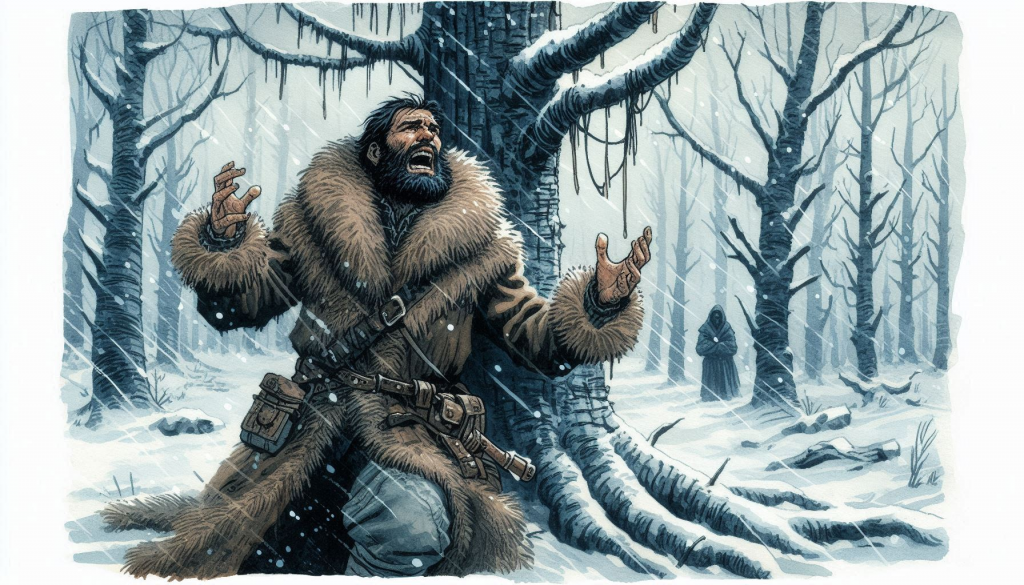
Before we move onto analysing Varamyr’s transgressions, let’s recall Haggon’s code of skinchanger ethics:
To eat of human meat was abomination, to mate as wolf with wolf was abomination, and to seize the body of another man was the worst abomination of all. Haggon was weak, afraid of his own power. He died weeping and alone when I ripped his second life from him. Varamyr had devoured his heart himself. He taught me much and more, and the last thing I learned from him was the taste of human flesh.
(A Dance with Dragons, Prologue)“Men may eat the flesh of beasts and beasts the flesh of men, but the man who eats the flesh of man is an abomination.”
(A Dance with Dragons, Prologue)
To summarise, Haggon’s “abominations” include:
- Cannibalism in wolf-form: Eating human flesh while inhabiting a wolf is forbidden.
- Mating in wolf-form: Engaging in carnal acts while controlling an animal is considered a grave violation.
- Human possession: Taking over another human’s body is deemed the ultimate abomination.
- Cannibalism: Consciously eating human flesh while in human form is an abomination.
These are taboos no warg should be engaging in, but why?
Varamyr’s First Abomination: Cannibalism in Wolf-Form
Varamyr breaks the first taboo when he consumes Haggon’s heart while inhabiting the body of his wolf, One-Eye. This act of proxy-cannibalism isn’t just gruesome; it’s transformative. By consuming Haggon’s heart, Varamyr essentially performed a blood ritual, one that possibly transferred Haggon’s magical strength to him, theregy enhancing his own magical ability.
I ate his heart and drank his blood, and still he haunts me.
(A Dance with Dragons, Prologue)
Moreover, as the beginning of the prologue chapter to aDwD indicates, he continued to feast on human flesh while in wolf-form thereafter.
My premise is that eating his mentor’s heart definitely marked a turning point in Varamyr’s skinchanging career. Consider his journey from Threeskins to Sixskins through the lens of this abomination.
Varamyr earned the name Sixskins because he had mastered six animals – three wolves, a shadowcat, a bear and an eagle. According to the warg himself, he could take any beast he wanted, but this was not always the case.
Prior to committing the abomination of consuming Haggon’s heart, he was known as Varamyr Threeskins, the three skins being his three wolves: One-Eye, Sly and Stalker.
It is after breaking the taboo of eating human flesh while inhabiting his wolf, that Varamyr begins to take on the skins of other beasts. Was Varamyr aware of potentially increasing his power by eating Haggon’s heart? Perhaps. Haggon never fully explained the consequences of breaking taboos. Varamyr may have unknowingly performed a blood ritual. On the other hand, Varamyr spoke of Haggon being afraid of his own power. His mentor also expressed strong disapproval for skinchangers who bonded with creatures other than wolves. This could suggest Haggon was aware of what was required to achieve that level of skill and power, and that he had shared that knowledge with his protégé, so whether Varamyr chose to betray his mentor in order to specifically advance his own magical power is somewhat unclear.
Evidence for an ‘unnatural binding’ to beasts other than wolves:
Varamyr’s childhood accounts and his intimate relationship with his wolves indicate he was born a warg. This is also reflected by how he thinks of his wolves, almost lovingly, as his brothers, his pack. According to him, inhabiting his wolves is like wearing an old boot.
My brothers. My pack. Many a cold night he had slept with his wolves, their shaggy bodies piled up around him to help keep him warm.
(A Dance with Dragons, Prologue)
Conversely, his relationship with his bear and shadowcat has a completely different quality to it. These creatures fight him, they resist him fiercely and do not succumb easily when he tries to inhabit them:
His shadowcat used to fight him wildly, and the snow bear had gone half-mad for a time, snapping at trees and rocks and empty air.
(A Dance with Dragons, Prologue)
It sounds as though the ‘boot doesn’t fit’. Considering the “brotherly” relationship he enjoyed with his wolves and ease with which he warged them, one wonders why he had such difficulty skinchanging the bear and shadowcat. That they fought him so vehemently implies he had no natural inborn spiritual connection to them. I would call this evidence of unnatural merging, not one that manifests as a result of a blood trait or an inherited ability, but rather acquired through the breaking of a taboo. Skinchanging those animals required force – bloodmagic does come at a cost, we know. After eating Haggon’s heart, Varamyr incorporates his mentor’s supernatural strength, thus building up his own power, allowing him to win the fight against those creatures’ resistance to surrendering to a violation of soul and body.
It is conceivable this abomination, this bloodmagic, unlocked greater supernatural power, elevating Varamyr from the status of a wolf-brother to the status of a skinchanger with substantially enhanced abilities.
Historical and In-Story Evidence for Powers granted through the Consumption of Human Flesh / the Heart
The practice of consuming the hearts of defeated enemies has appeared in various cultures throughout history. Often, it was done to absorb the life-force, strength, courage, or essence of the fallen. Notable examples include:
-
-
- the Aztecs – Ritual Heart Consumption
- the Scythians – Drinking the Blood of Their Enemies
- the Maori – Utu and the Eating of Hearts
- the Mongols – Consuming the Hearts of Fallen Warriors
- European Medieval Lore – Blood and Heart Consumption
-
Why did ancient civilizations engage in such intense practices? The reason lies in their belief systems; many ancient cultures considered the heart to be the seat of strength, courage, and even the soul. Consuming the heart was believed to transfer these valuable attributes to the victor. The practice was often reserved for strong and courageous fallen enemies, whose hearts were eaten by the victorious to enhance their own strength and formidability.
There are several instances where George Martin draws on this principle, weaving the idea into the story in various ways. Think of Daenerys’ horse-heart-eating ceremony. The Dothraki believed that consuming the bloody raw heart of a stallion during pregnancy would imbibe her son with strength. Eating the entire heart without throwing up was essential to ensuring this spiritual transfer of the horse’s strength into the unborn child.
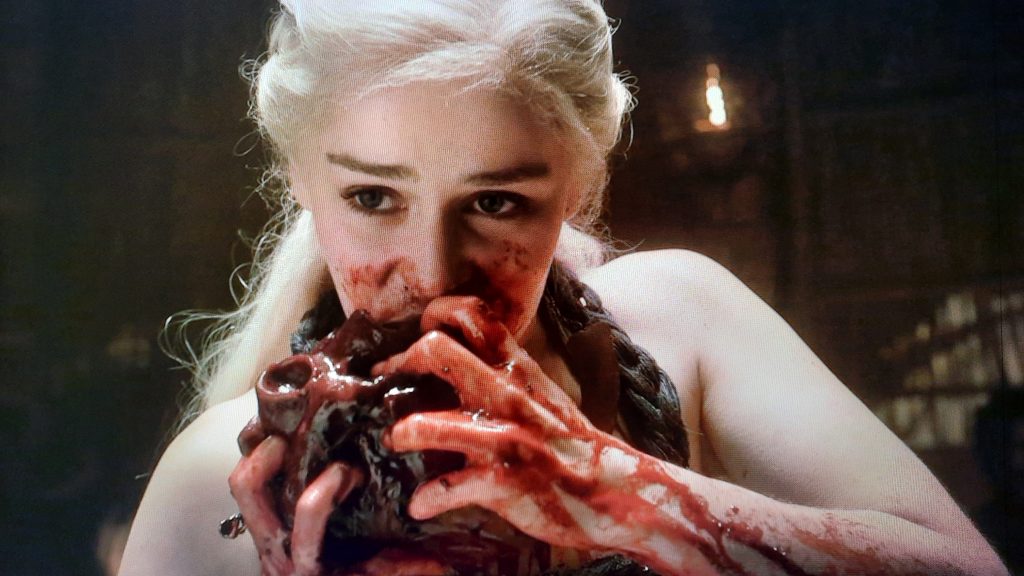
The Legend of the Forging of Lightbringer
While there are occurrences of the victorious drinking the blood of vanquished enemies in Essos, by far the best example of the transferal of strength located in the heart is the legend of the forging of Lightbringer. Azor Ahai sacrificed his wife Nissa Nissa by thrusting his newly forged sword through her heart. And as legend has it, her blood and her soul and her strength and her courage all went into the steel, thereby creating a magical weapon powerful enough to withstand and destroy the Others. This perfectly echoes the beliefs of the ancients.
What better piece of evidence can we find for the heart as the most important location of spiritual power in an individual?
Here’s that famous passage once again:
“Nissa Nissa,’ he said to her, for that was her name, ‘bare your breast, and know that I love you best of all that is in this world.’ She did this thing, why I cannot say, and Azor Ahai thrust the smoking sword through her living heart.
It is said that her cry of anguish and ecstasy left a crack across the face of the moon, but her blood and her soul and her strength and her courage all went into the steel. Such is the tale of the forging of Lightbringer, the Red Sword of Heroes.”
(A Clash of Kings, Davos I)
What Melisandre’s attack on Orell’s eagle reveals:
The role of the heart as the seat of power is also illustrated by what happens when Melisandre attacks Orell’s eagle while Varamyr is inhabiting the bird. The text vividly describes this moment:
“The flames devoured him inside, turning his heart into a blackened cinder and sending his spirit screaming back into his own skin. For a little while he’d gone mad.”
(A Dance with Dragons, Prologue)
Varamyr had died nine times while inhabiting an animal prior to being subjected to Mel’s magical fire, yet this was his worst experience by far. When the eagle is struck by Mel’s fire magic, Varamyr experiences its death almost as his own. The fire drives his spirit out of the eagle and kills the bird.
It is important to note that Varamyr’s heart is the primary target of the fire, representing the metaphysical seat of his strength and soul. Melisandre’s fire transforms it into a charred cinder, effectively symbolizing the spiritual destruction of his power. Observe how the skinchanger immediately loses control of the situation, with his spirit being forcibly returned to his own body.
Once Mel’s cleansing fire eradicates the unnatural power he acquired through his abominable actions, Varamyr also loses his control over the snow bear and shadowcat. The burning heart thus symbolizes the destruction of the source of spiritual power, a power obtained through betrayal and treachery by Varamyr. Only the warg’s wolves, his natural pack, remain loyal. Further, Varamyr understood that he would no longer be able to dominate the snow bear and shadowcat thereafter.
Recall also Varamyr’s reflection on Haggon: “I ate his heart and drank his blood, and still he haunts me.” Given that the heart is considered the seat of the soul, it is understandable that Varamyr feels haunted by the mentor whose heart he consumed. Varamyr literally carries Haggon’s spiritual essence within himself.
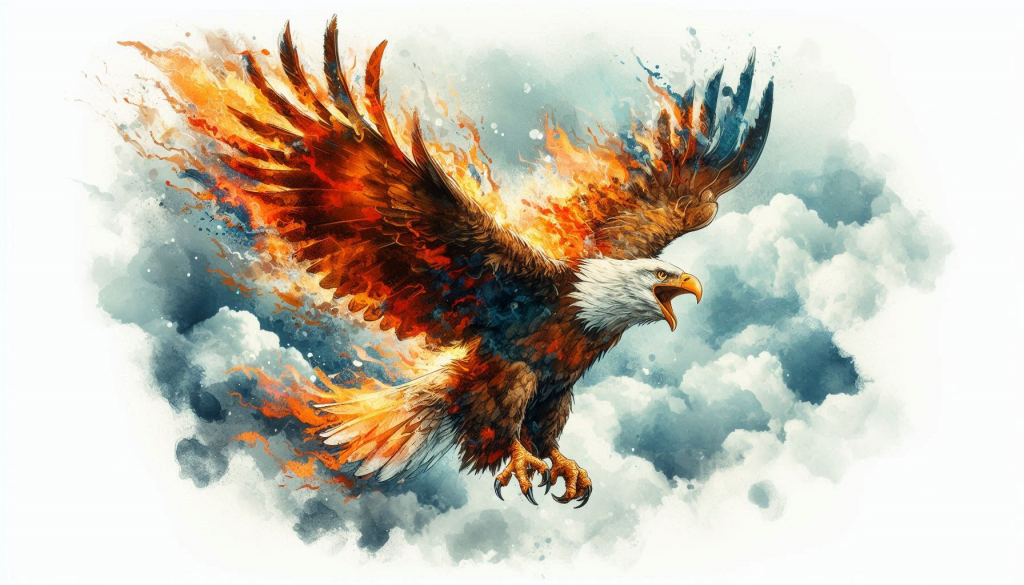
Varamyr’s Second Abomination – Mating while in Wolf-Form
Varamyr describes frequently slipping into his female wolf Sly while she was being mounted by One-Eye. In this case, Varamyr breaks the taboo prohibiting a warg from mating with another wolf during spiritual inhabitation. Which additional powers could Varamyr have gained by this act? Well, since the rule forbids sexual relations, examining this aspect of the skinchanger’s life may be the key to unravelling the mystery.
Consider his love-life: Varamyr was not interested in wooing women or fighting for their favour as was traditional in wildling society. Instead, we learn he satisfied his physical needs by sending his shadowcat to stalk women and lead them home to his cabin.
By Varamyr’s own account, his shadowcat appeared to have very strange powers:
Whenever he desired a woman he sent his shadowcat to stalk her, and whatever girl he’d cast his eye upon would follow meekly to his bed. Some came weeping, aye, but still they came.
(A Dance with Dragons, Prologue)
It’s rather unconventional, don’t you think, that Varamyr sends the cat to stalk women, essentially to fetch them to him. Additionally, the beast appears to have some kind of mesmerizing power flowing from Varamyr, who “casts his eye” upon them, compelling the women to follow. The passage makes it clear that the women do not come willingly and stresses that they come all the same, following the shadowcat. That Varamyr sends the cat is odd because it suggests he does not need to inhabit the animal for this purpose. It sounds rather like folklore specific to a familiar animal – one that carries out a witch’s bidding – an animal the witch sends out to do whatever she needs done.
The Stark children train their wolves to obey commands but so far, we have not seen similar behaviour. In fact, Bran gives up trying to teach Summer to fetch a mere stick. The direwolf is disinterested and simply ignores the command. Why then, does a shadowcat, presumably even more difficult to train than a wolf or dog, do its master’s bidding? I suspect there is something other than skinchanging at work here but what? I suspect by breaking this taboo, the skinchanger gains supernatural control over others.
Supernatural Control
This act of sending another creature to do one’s bidding coupled with compelling power over another person reminds me of 2 things:
- The control white walkers wield over the undead, enabling their use as an army. The act of sending wights after Sam and Gilly to retrieve Craster’s son and even exerting control over the undead south of the Wall – as evidenced by the undead Night’s Watch brother’s attack on Lord Commander Mormont.
- The great desire Night’s Queen inspired in the 13th Lord Commander of the Night’s Watch, compelling him to go after her and ultimately forsake his vows so utterly and completely. In this analogy, Night’s Queen plays the role of Varamyr’s shadowcat while Night’s King stands in for the women who follow the cat to Varamyr’s cabin. According to legend Night’s King actually chases her after spying her from atop the Wal. Was he mesmerized by her? Was she exerting supernatural control over him? Was it impossible for him to not respond to her supernatural call?
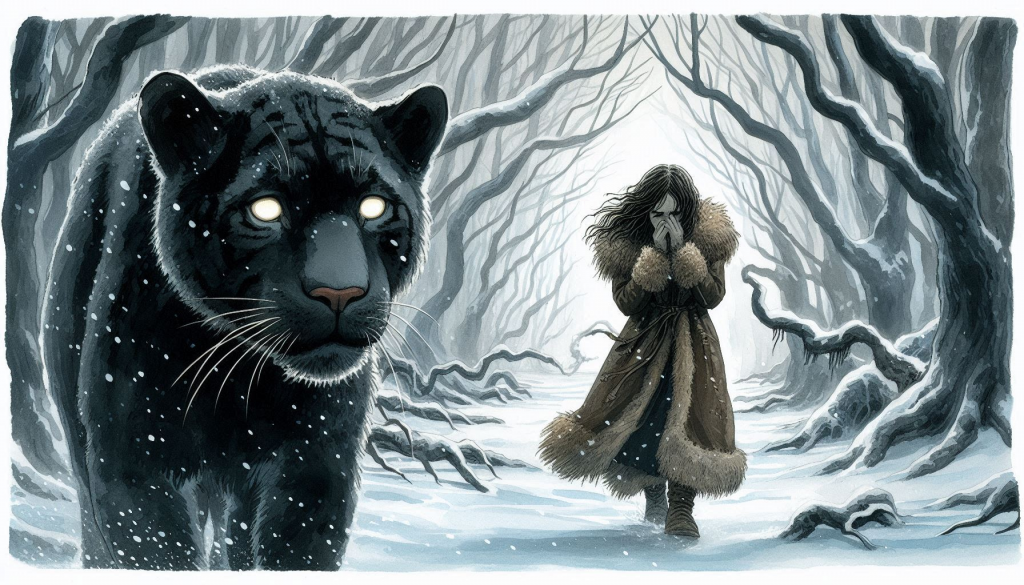
Sending shadowcats to procure women and compel them to follow is not in the realm of the natural. I suspect the power to send the cat and Varamyr’s apparently hyptnotic control over women through the shadowcat, must stem from breaking the taboo of mating with a wolf while inhabiting another wolf. Varamyr certainly did this and the sex-association makes it feel right.
Breaking the mating-taboo gives the skinchanger more control over his familiar animal – he can, for example, give it commands and send it to carry out specific tasks. It also gives him control over other individuals, who are unable to resist his “call,” responding instead to his orders (women following meekly to his cabin).
Varamyr’s third and fourth abominations
The transition from skinchanging to greenseeing represents a deeper level of magical mastery in aSoIaF. Varamyr’s final moments offer a rare glimpse into this transformation, which is mediated by cannibalism and by having achieved possession of the body of another human being.
As Varamyr’s death approaches, he attempts to seize the body of the spearwife Thistle. Unlike Bran’s co-existence with Hodor, Varamyr’s goal is total domination, driving out Thistle’s soul in order to claim her body for himself.
No one will ever know. I will be Thistle the spearwife, and Varamyr Sixskins will be dead. His gift would perish with his body, he expected. He would lose his wolves, and live out the rest of his days as some scrawny, warty woman … but he would live. If she comes back. If I am still strong enough to take her.
(A Dance with Dragons, Prologue)
Thistle does come back. Note he also wonders if he is strong enough to take her. She puts up a terrific fight when Varamyr forces is spirit into her:
Varamyr had half a heartbeat to glory in the taste of it and the strength of this young body before her teeth snapped together and filled his mouth with blood… When he tried to scream, she spat their tongue out.
(A Dance with Dragons, Prologue)
She resists fiercely, biting off their tongue, filling his mouth with blood.” Pay attention to the language used. The references to “glorying in the strength of her young body” and “their tongue” suggest Varamyr made progress in possessing her. This is important because though he ultimately fails to take over her entire body, he does momentarily partially succeed in merging his soul with her flesh. Of course Varamyr had lost much of his extra, ill-acquired supernatural power after suffering Mel’s attack.
Notice also in particular the blood-drinking as an act of cannibalism because it is Thistle’s tongue that is severed, her blood that inadvertently filling his mouth and which he may have swallowed.
In the next instant, as he is dying, Varamyr’s spirit connects with the weirwood. For a brief moment, he becomes a greenseer, and is able to see through the carved eyes of the tree:
The white world turned and fell away. For a moment it was as if he were inside the weirwood, gazing out through carved red eyes as a dying man twitched feebly on the ground and a madwoman danced blind and bloody underneath the moon, weeping red tears and ripping at her clothes. Then both were gone and he was rising, melting, his spirit borne on some cold wind.
(A Dance with Dragons, Prologue)
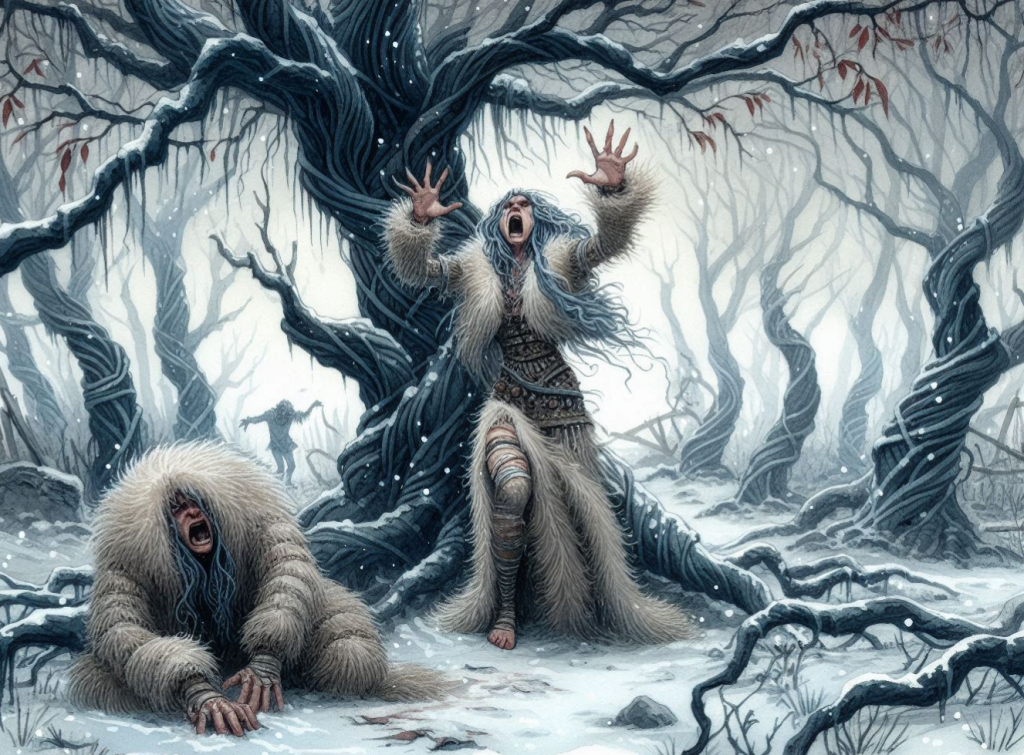
The entire struggle takes place near the weirwood tree. There is blood spilling near the weirwood, death under the tree – Thistle’s and his own – as if sacrificed to the tree. In this scenario, the worst violations converge at a place of power, a source of ancient magic.
- The more obvious offence – partially taking over a human body.
- The less obvious one – potential cannibalism (drinking Thistle’s blood).
By breaking these taboos, together with the accidental blood ritual at the tree, Varamyr becomes one with the weirwood and gains fleeting greenseeing ability in the process.
Key Takeaways
Varamyr Sixskins may be a villain, but he also provides a fascinating study on how violating certain norms and taboos in aSoIaF can actively enhance magical power. While Haggon framed these taboos as absolute abominations, Varamyr’s journey suggests that breaking them actually serves to increase a warg’s power. Each broken taboo unlocks a new level of magical mastery.
- Breaking the taboo of consuming human flesh while inhabiting a wolf unlocks greater skinchanging potential – From Threeskins to Sixskins. Before committing this act, Varamyr was just a wolf-brother; afterward, he became a true skinchanger, able to control a bear, a shadowcat, and even an eagle. This exploration suggests the heart as the source of the mystical essence that amplifies the warg’s magic.
- Mating while in wolf-form is another major taboo, but Varamyr’s experiences suggest this violation granted him control over his shadowcat transcending skinchanging. Additionally, Varamyr, through the shadowcat, exhibits eerie abilities, compeling women to follow to their doom.
This power, reminiscent of supernatural enthrallment, raises the question: does violating the sexual boundary between man and beast allow a skinchanger to manipulate not just animals, but people as well? Could this be at the heart of the magic employed in controlling the undead? - Attempting to possess another human, combined with cannibalism, appears to be the gateway to greenseeing. In his final moments, Varamyr touches something far older and more powerful than himself: his spirit merges, if only briefly, with the weirwood and he is able to see the world through its eyes.
These are eerie parallels to what Bran undergoes, though Varamyr’s transformation is more violent and chaotic. Still, the implication remains: ultimate power lies beyond mere warging, and the greatest transgression—taking another human’s body—may be the key to unlocking it.
What does this mean for Bran? Could breaking taboos, consciously, deliberately or not, speed up his journey to becoming a greenseer? That’s what we’ll explore in part two.
Podcast Summary
Credits
Podcast Summary of this post generated from the skript by NotebookLM (12 mins.)
Images are AI-Generated using Bing.
Film image of Daenerys from the HBO Series A Game of Thrones
